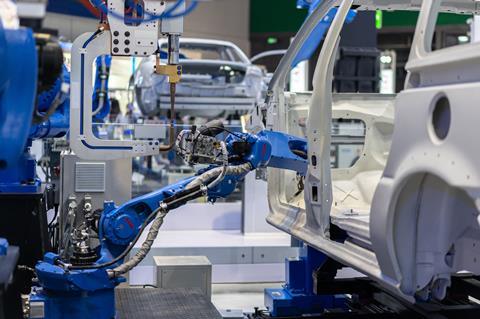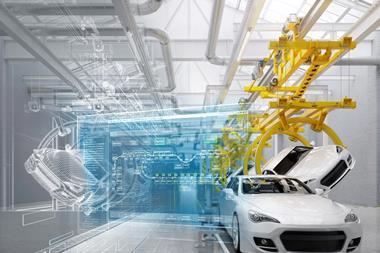As the automotive industry transitions to producing a new generation of electric vehicles, Volker Schwickert, vice president for QMS Software, Global Portfolio Development, Siemens Digital Industries Software, discusses how quality management must adapt to meet new market challenges

What we are seeing in the automotive industry now is a perfect storm, which requires the digital infrastructure, by which vehicles are designed, produced and delivered, to innovate just as fast as the vehicles themselves, and today that is a very fast pace. Quality management is at the heart of that digital infrastructure, and it is imperative it keeps pace with today’s growing demands while still delivering the standards the consumer expects.
Market challenges
We are seeing rapid technology advancements that are redefining transportation – moving away from traditional mechanics to electrification and autonomous driving. The car has become a complex, sustainable system that can drive automatically, entertains the passengers, and connects with online traffic services. It has evolved from a mechanical metal product with some electronics to a complex software system with a high level of electronics content.

We also must face the growing climate change issues that require radical transformations to achieve better sustainability. In addition to electrification, traditional cars need greater efficiency and lower emissions. All of this requires rapid innovation and alternative powertrains.
Although globalisation has been a trend for decades, the current geopolitical conditions, exacerbated by the pandemic, have created greater supply chain vulnerability. Supply disruptions, especially in electronics and semiconductors, have increased bottlenecks. Today, order books are full, but the cars can’t be produced fast enough to meet consumer demand. This is completely different from previous crises when orders plummeted.
When manufacturers try to solve these problems, they go back to local sourcing, change their suppliers, and ramp up inventories. Decades of developing processes to drive inventory to zero are being upended.
The auto manufacturing market dichotomy
As new innovators have entered the market, a dichotomy has emerged with traditional OEMs. Although they are facing the same challenges, they are competing with different strengths. New market entrants are not encumbered by infrastructure that was built for traditional technology and are nimbler in their ability to deliver innovation.
Yet, these new entrants do not have the long-standing industry expertise of their traditional counterparts. They need people in the organisation who can perform development quickly, who are able to personalise products and handle the increasing number of vehicle variants from design to order to production to delivery.
The incumbent OEMs have been part of an industry that pioneered quality practices. Although these OEMs have made huge investments in launching new vehicles – creating new design and production processes, involving their suppliers and meeting target quality – they have been challenged by demands to accelerate time to market for their products. Now, as they compete against these agile market disruptors, they continue to fall behind the pace of innovation.
The good news for the traditional OEMs is their investment power can transform their digital manufacturing infrastructure, and they are doing so with an accelerated roadmap. These manufacturers need significant investment in R&D, to develop new technologies that support electrification and autonomous driving.
Some of them have tried to carry on with traditional processes and outmoded equipment, but it is not possible. It creates a lot of risks, including production line disruption, cybersecurity threats and penalties for noncompliance with sustainability rules and regulations. Addressing the new technologies is a huge challenge.
Across the industry, however, the quality challenges are the same. With supply chain insecurity, alternative suppliers must be identified and validated more quickly. When you look at quality projects, like Advanced Product Quality Planning (APQP) or Production Part Approval Process (PPAP), which are defined in automotive norms, it puts an enormous amount of pressure on timing and deadlines.
The personnel shortages and travel restrictions we are experiencing are also impacting quality. For example, supplier and customer audits need to be done remotely or in a hybrid approach. This is creating the need for better collaboration solutions, so participants can mitigate quality issues with proven methods.
Quality management evolves to meet these needs
At Siemens Digital Industries Software, we have worked with the major OEMs and suppliers for decades, to optimise their quality processes, developing and delivering modern quality management systems to help them accelerate their digital transformation projects. We know first-hand the critical issues these systems must address across the industry, and further how they must fit into the smart manufacturing landscape to create the digital enterprise of the future. The solution approach requires a holistic quality management strategy across the entire enterprise and out to the extended value chain.
Consider a global company that makes auto parts and has numerous plants around the world. If each plant has several departments with a vast number of resources, constraints, and quality approaches, the only way to manage them is in a collaborative environment that houses relevant data, quality standards and best practices. This comprehensive system needs to be used to work towards fast and effective issue resolution, while informing all functions of required changes and actions.
When you look at global standards such as ISO-9000, and industry-specific supplements or guidelines, such as those developed through the IATF 16949 or AIAG/VDA, you see the ever-changing landscape of quality requirements. Quality management systems must be able to adapt to these changes on a global basis. Whether it is a new form or procedural improvements that include new templates and methodologies – the quality management solution must keep pace.
However, in the conventional quality cycle, a gap has persisted between engineering and manufacturing. This is a key area in which building quality management on top of a smart manufacturing architecture transforms the value chain. A closed-loop approach completes the cycle from engineering to manufacturing to supply chain, and field services. This is only possible with a comprehensive digital twin – where the quality information is connected across the product lifecycle.
A digital twin enables a feedback loop back to the lifecycle for continuous improvement. We have focused on creating this comprehensive foundation within our Siemens Xcelerator portfolio, which is a comprehensive portfolio of software, hardware and services. We see the digital twin not only connecting quality to manufacturing operations, but also connecting the entire lifecycle from product design, engineering, simulation, test and production to field performance.

Leveraging such a portfolio, the manufacturer should be able to start with design for quality, leverage 3D models and the BOM and BOP structures that are already there to improve quality process interactions. Failure mode and effects analysis (FMEA) is fed back to the control plans and failure catalogues that need to be monitored across the lifecycle. The manufacturer must move beyond just finding problems – their systems should be preventing problems before they occur. Compliance is a by-product of the system – it must be built in.
For example, methods like cause-and-effect diagrams or 5Whys, which are used to analyse root cause, would previously be incorporated into the quality process as an attachment, where the system would document what people did on paper. Now it is fully integrated in the system and allows people to work interactively. People in the company must collaborate across department borders, but also with suppliers and customers. We are moving from a top-down, hierarchical approach to a networked approach.
Simulation and variation analysis are important functions that are enabled by the digital twin. In the digital realm, manufacturers can simulate design to production, do product planning and production process planning, and the digital backbone can be used to sort out quality problems before real production stars, where the cost of correcting a problem is much higher.
The continuous improvement process can also be enhanced by IIoT, artificial intelligence and machine learning to enable a more predictive approach to quality. These capabilities accelerate the pace of innovation with minimal failures, reducing costs in time and materials, and attaining target quality in product launches.

Another capability of modern digital manufacturing tools is the ability to quickly adapt to the changing needs of the business and extend core solutions further into the value chain. Integrating a low-code platform allows users to create easy-to-use interfaces and workflows for every participant in the value chain – many of whom are not specialists in the traditional lifecycle functions. These solutions extend the value of the core enterprise systems, while preserving their mission-critical backbone and business logic.
Cloud accessibility is another key requirement for the future of quality management. Cloud deployment results in tremendous cost benefits and its enhanced accessibility is important as we move to a more IoT-centric product.
The bottom line is there is a strong business case for digital transformation and quality management. When both OEMs and suppliers implement a comprehensive quality management solution, it accrues enormous benefits. Processes are harmonised, security is strengthened, resources are rationalised, scrap and rework are reduced, warranties and goodwill are improved; corrective and preventive actions are more rapid and effective. Ultimately, target quality is accelerated with new product introductions and as a result, customer satisfaction and loyalty grow.

































